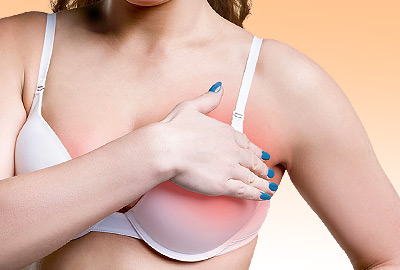Breast pain is a common affliction among women of all ages, affecting some more frequently and severely than others. At times this can cause concern, especially if you are unaware of the possible reasons why you might be experiencing it, and you do not fully understand the different types of breast pain. Generally, doctors group different types of breast pain into three categories; cyclic, non-cyclic, and extra-mammary. Read on to find out more about non-cyclical breast pain, what causes it, and how it can be managed.
What Is Non-cyclic Breast Pain?
The term “non-cyclic breast pain” refers to pain that is not correlated to the menstrual cycle, it is sometimes known as non-cyclic mastalgia. It can range from a mild discomfort to more intense sensation, and might be constant or intermittent. This type is common among menopausal women, although younger women can suffer too. It is possible for non-cyclic breast pain to be present in a range of areas; the breast tissue itself, the ribs underneath, or from another condition which affects the chest. In most cases, the pain is only present in one breast.
What Causes Non-cyclic Breast Pain?
Women who are accosted with non-cyclic breast pain often - understandably - become troubled with concerns about breast cancer. While it is advisable to visit your doctor and undergo checks, it is important to note that any breast pain in general is rarely a consequence of cancer. Common non-cyclic breast pain causes include:
Trauma
If the area is confronted with any trauma such as caused by injury or surgery, this might lead to localized pain. Conditions like inflamed ribs can radiate through to the breast leading to aching. The condition may occur in both premenopausal and postmenopausal women and usually subsides after one to two years. However, non-cyclical breast pain does not indicate breast cancer, though women should discuss the condition with their physicians.
Breast size
Women with large breasts may have non-cyclic breast pain related to the size of their breasts. Neck, shoulder, and back pain may accompany breast pain due to large breasts.
Cysts
Sometimes benign lumps or cysts can grow, or abscesses can appear. Abscesses are generally a consequence of an infection, and can cause soreness in a specific area.
How to Treat Non-cyclic Breast Pain
If you experience non-cyclical breast pain, first of all it is recommended that you visit your doctor to discuss your symptoms. Depending on the reason behind your pain, helpful treatments might be:
Taking a warm bath or using a hot water compress
Wearing a comfortable, and supportive bra
Anti-inflammatory tablets or topical cream
Over-the-counter painkilling medication
Improvement in diet and exercise regime
Increased intake of fluids
Treatment methods will largely depend on the cause of your non-cyclic mastalgia, but it can be helpful to be aware of some of the most effective pain relief techniques, for immediate action.
While non-cyclical breast pain can be disconcerting and even upsetting, it should hopefully be somewhat comforting to know that it is a fairly common condition and so it has been thoroughly explored. This means that usually it is possible to find a successful method for alleviating it quickly.
Sources
- Breast Cancer Care. (2015). Breast pain. Retrieved May 30, 2017, from https://www.breastcancercare.org.uk/publications/benign-breast-conditions/breast-pain-bcc71
- Imaginis.(n.d.).Breast Pain Causes -Pain in one or both breast. Retrieved September 25, 2017, http://www.imaginis.com/breast-health-101-cancer/breast-pain
- Mayo Clinic. (2015). Breast pain. Retrieved May 30, 2017, from http://www.mayoclinic.org/diseases-conditions/breast-pain/symptoms-causes/dxc-20167381
- Patient. (2016). Breast pain. Retrieved May 30, 2017, from https://patient.info/health/breast-pain-leaflet
- National Health Service UK. (2016). Mastitis. Retrieved May 30, 2017, from http://www.nhs.uk/conditions/Mastitis/Pages/Introduction.aspx
- National Health Service UK. (2014). Breast lumps - Causes. Retrieved May 30, 2017, from http://www.nhs.uk/Conditions/Breast-lump/Pages/Causes.aspx




